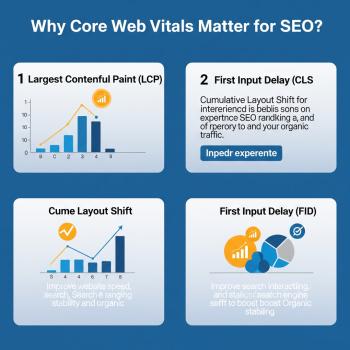
Posted on: 2 months ago
How to Improve Core Web Vitals for Better Google Rankings
CLS, Core Web Vitals, FID, Google Ranking, LCP, SEO, Website Performane
33 | 0 | 1
In today’s digital world, your website’s performance isn’t just about speed—it’s about user experience, and Google is paying close attention. One of the most important updates in recent years is the emphasis on Core Web Vitals, a set of specific metrics that measure the quality of user interactions on your site. If you're aiming for better visibility on search engine result pages (SERPs), optimizing Core Web Vitals is no longer optional—it’s a necessity.
Let’s break down what Core Web Vitals are and explore actionable strategies to improve them and boost your Google rankings.
What Are Core Web Vitals?
Core Web Vitals are a group of three performance metrics introduced by Google to quantify key aspects of user experience:
- Largest Contentful Paint (LCP) – Measures loading performance. A good LCP score is under 2.5 seconds.
- First Input Delay (FID) – Measures interactivity. Aim for less than 100 milliseconds.
- Cumulative Layout Shift (CLS) – Measures visual stability. Keep it below 0.1.
Google uses these metrics to assess how smooth and engaging your site feels to real users. Poor performance in any of these areas can hurt your SEO.
Why Core Web Vitals Matter for SEO
Since 2021, Core Web Vitals have become part of Google’s Page Experience ranking signals. While they aren’t the only factor affecting rankings, improving them can significantly boost your site’s chances of appearing higher in search results, especially in competitive niches.
How to Improve Core Web Vitals
1. Optimize Your Images
- Use modern formats like WebP or AVIF.
- Compress images without losing quality using tools like TinyPNG or ImageOptim.
- Set correct dimensions to prevent layout shifts.
2. Implement Lazy Loading
Lazy loading defers offscreen images and videos until a user scrolls to them, which speeds up LCP and reduces bandwidth usage.
<img src="image.jpg" loading="lazy" alt="example">
3. Minimize Render-Blocking Resources
- Use asynchronous loading for CSS and JavaScript.
- Minify and combine CSS/JS files using tools like Terser, UglifyJS, or Webpack.
4. Use a Content Delivery Network (CDN)
A CDN like Cloudflare, Fastly, or BunnyCDN stores your content on multiple servers globally, which reduces load time and improves LCP.
5. Prioritize Critical Content
Ensure that the most important elements (above-the-fold content) load first. This can be done using critical CSS and deferring non-essential scripts.
6. Reduce JavaScript Execution Time
Heavy JavaScript slows down interactivity. Audit your scripts using Lighthouse or Chrome DevTools, and eliminate unused code.
7. Avoid Layout Shifts
- Reserve space for dynamic content (like ads or iframes).
- Use width and height attributes in your image and video tags.
- Avoid injecting new content above existing content.
8. Improve Server Response Time
A slow server delays everything. Consider:
- Switching to a faster web host.
- Using HTTP/2 or HTTP/3.
- Optimizing database queries.
9. Preload Important Resources
Inform the browser about the important resources early on.
<link rel="preload" href="style.css" as="style">
10. Monitor with Tools
Regularly test and monitor your performance using:
- Google PageSpeed Insights
- Lighthouse
- Web Vitals Chrome Extension
- Google Search Console (Core Web Vitals Report)
Real-Life Example: Before and After Optimization
One e-commerce site had a CLS of 0.34, a poor rating. By reserving space for banners and product images and switching to system fonts, they reduced CLS to 0.06 and saw a 17% uplift in organic traffic in 2 months.
Improving Core Web Vitals is not a one-time task—it’s an ongoing process that requires performance audits and refinements. But the benefits go beyond just SEO. A faster, more stable site improves user satisfaction, reduces bounce rates, and boosts conversions.
If you’re serious about staying competitive on Google, start optimizing your Core Web Vitals today—and stay ahead of the algorithm.
Welcome to CodePits.
CodePits provide a collection of tutorials about many programming languages like PHP, Laravel Framework, Codeigniter Framework, Mysql Database, Bootstrap Front-end Framework, Jquery, Node JS, Ajax Example, APIs, CURL Example, Composer Packages Example, AngularJS, Ionic Framework, etc. 🙌
Other Posts
Categories
Tags
Comment
 PR
PR Home
Home Demos
Demos Near By
Near By
Comments (0)
🤔
No comments yet, be the first to help
load more